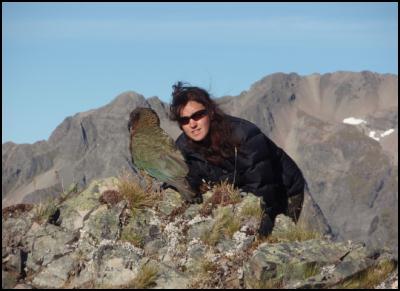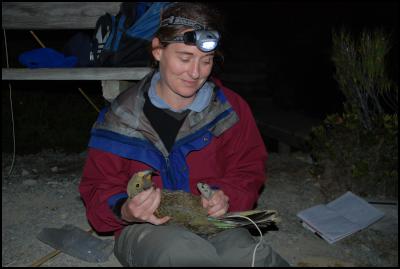NZ mountain plants may depend on declining kea, UC lecturer
NZ mountain plants may depend on declining kea, UC
lecturer says
November 1, 2012
Over summer many holiday trampers will get close up views of New Zealand’s most charismatic bird, the kea.
However a University of Canterbury lecturer, Dr Ximena Nelson, said plants in New Zealand’s mountains are under threat as kea numbers continue to decline.
Dr Nelson said kea numbers were diminishing which could be bad news for about 12 percent of New Zealand’s alpine plants that rely on kea for seed dispersal.
``Kea are mischievous and lovable and also threatened, in part because we persecuted them for decades. From the late 1800s until 1971, the government placed a bounty on kea beaks. In the 1920s, the bounty was 10 shillings per beak, equating to $65 today.
``After an estimated 150,000 kea were killed, the wholesale bloodshed ended in a full protection for the species in 1986. However, kea sometimes do still fall foul of a bullet and now it is likely than there are considerably less than 5000 birds left.
``All of this was because of this birds’ powerful beak, which can occasionally cause a sheep’s death. However, this beak is not only destructive, but also has the power to give life,’’ Dr Nelson said.
Laura Young, a PhD student at UC, has also investigated the foraging behavior of kea and found that they spend a large proportion of their time eating fruit. New Zealand’s mountains have an unusually high proportion of fruit-bearing plants, making fruit an ideal food for the world’s only alpine parrot.
However, to maintain genetic viability the plants need to disperse their seeds and there are few remaining native species that may be able to do the job, Dr Nelson said.
Previously it had been assumed that like other parrots, the kea’s beak would make mincemeat of the seeds contained in the fruit that they eat, thereby contributing little to seed dispersal.
``Laura’s work showed that kea selected more fruiting species, consumed more fruit and dispersed more seeds than all other birds seen in the mountains combined. When she looked carefully at the seeds contained in hundreds and hundreds of kea faeces, she found that in fact almost all seeds were intact.
``Furthermore, kea are the only species that make frequent long-distance flights within and between mountain ranges. Hence, much of the effective long-distance dispersal of the alpine flora may be currently performed by kea.
``The fact that kea are able to ingest fruit and rarely crush seeds despite their powerful curved ‘parrot’ beak is noteworthy. These large birds can damage motor vehicles, buildings and signs, yet they can manipulate delicate items with considerable dexterity, providing another good reason to cherish these clever birds.’’
In addition to illegal hunting and pet trade activities, other major threats to kea populations include predation, competition for resources with introduced mammals and humans, lead poisoning and habitat degradation, Dr Nelson said.
Both Dr Nelson and Young are continuing research into kea, listed as a nationally endangered species.
Photos: UC’s
Laura Young

and Ximena Nelson

Click for big version.
ENDS


 Business Canterbury: Urges Council To Cut Costs, Not Ambition For City
Business Canterbury: Urges Council To Cut Costs, Not Ambition For City Wellington Airport: On Track For Net Zero Emissions By 2028
Wellington Airport: On Track For Net Zero Emissions By 2028 Landcare Research: ANZAC Gall Fly Release Promises Natural Solution To Weed Threat
Landcare Research: ANZAC Gall Fly Release Promises Natural Solution To Weed Threat NZ Anti-Vivisection Society: Auckland Rat Lovers Unite!
NZ Anti-Vivisection Society: Auckland Rat Lovers Unite! University of Canterbury: $1.35 Million Grant To Study Lion-like Jumping Spiders
University of Canterbury: $1.35 Million Grant To Study Lion-like Jumping Spiders Federated Farmers: Government Ends War On Farming
Federated Farmers: Government Ends War On Farming



